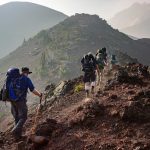Trekking is an adventurous and exhilarating activity that allows individuals to explore nature, challenge themselves physically and mentally, and experience diverse landscapes. However, to have a safe, comfortable, and enjoyable trekking experience, it is essential to choose the right clothing.

This article delves into the reasons, why clothing is important in trekking and provides guidance on selecting appropriate attire for a successful trek.
Protection from the Elements
One of the primary functions of clothing during trekking is to shield you from the elements. Trekking often involves traversing through varied terrains and weather conditions, such as rain, snow, strong winds, and scorching sun. Proper clothing can protect you from harsh weather and prevent injuries, hypothermia, frostbite, and sunburn.
Temperature Regulation
Trekking can lead to significant fluctuations in body temperature due to physical exertion, changing altitudes, and varying weather conditions. Wearing suitable clothing helps regulate your body temperature, ensuring that you stay warm during cold conditions and cool during hot conditions. Proper temperature regulation can prevent overheating, excessive sweating and chills, which are not only uncomfortable but can also be dangerous in some cases.
Moisture Management
Sweating is a natural response to physical exertion, and it’s common to perspire while trekking. However, excessive moisture can make clothing damp, causing chafing, irritation, and discomfort. Moreover, wet clothing loses its insulating properties and can lead to hypothermia in cold conditions. Clothing designed for trekking typically features moisture-wicking materials that draw sweat away from your skin, keeping you dry and comfortable throughout your journey.
Freedom of Movement
Trekking often involves navigating through rugged terrains and overcoming obstacles such as rocks, fallen trees, and steep inclines. To tackle these challenges, you need clothing that allows for unrestricted movement. Clothes that are too tight, heavy, or bulky can restrict your movement and cause discomfort or injury. On the other hand, lightweight, flexible, and well-fitting clothing can enhance your mobility and help you tackle challenging terrains with ease.
Durability
Trekking exposes your clothing to rough terrains, abrasive surfaces, and harsh weather conditions. As a result, it’s crucial to opt for durable clothing that can withstand the journey’s rigors. High-quality materials and sturdy construction ensure that your clothes remain functional and comfortable throughout your trek and last for multiple expeditions.
Tips for Choosing the Right Clothing for Trekking
Now that you understand the importance of clothing in trekking, here are some tips for selecting appropriate attire:
- Layering: Dress in layers to regulate your body temperature effectively. A typical layering system consists of a moisture-wicking base layer, an insulating mid-layer, and a waterproof and windproof outer layer.
- Material: Opt for materials that are lightweight, breathable, and quick-drying, such as synthetic fabrics or merino wool. Avoid cotton, as it retains moisture and dries slowly.
- Fit: Choose clothing that fits comfortably without restricting movement. Clothes should be snug enough to retain warmth but not so tight that they impede circulation.
- Footwear: Select supportive, waterproof, and breathable hiking boots or shoes with good traction. Don’t forget to wear moisture-wicking socks designed for hiking.
- Accessories: Use accessories like hats, gloves, and neck gaiters to protect your extremities and enhance your comfort.
Conclusion
Clothing plays a crucial role in trekking and hiking. Appropriate clothing can make or break an outdoor adventure. The right clothes provide protection from the elements, prevent health issues like hypothermia, and allow for full range of movement. Trekking-specific clothing is designed to maximize comfort and safety in the outdoors. No matter the weather conditions or terrain, wearing the proper clothing is essential to having an enjoyable and safe trekking experience.



GIPHY App Key not set. Please check settings